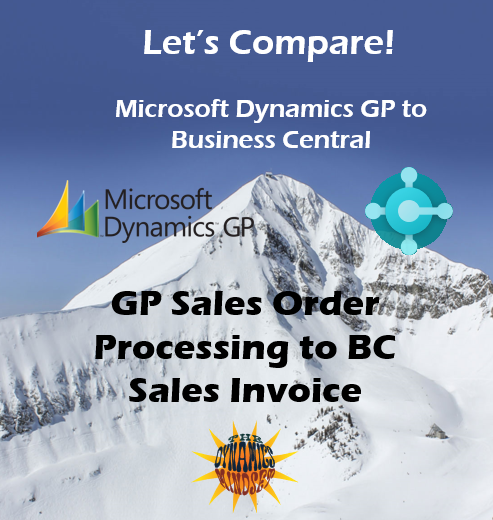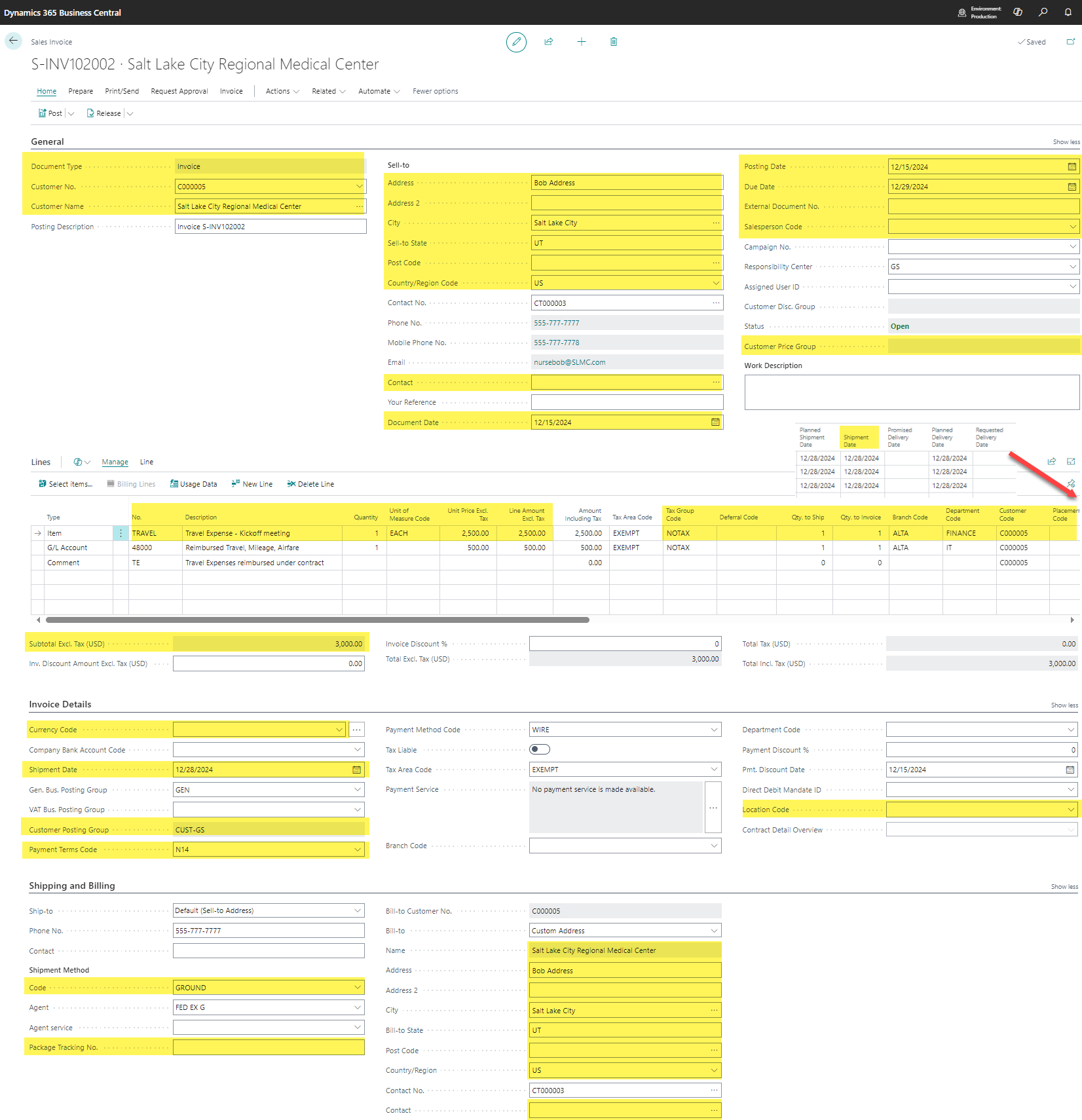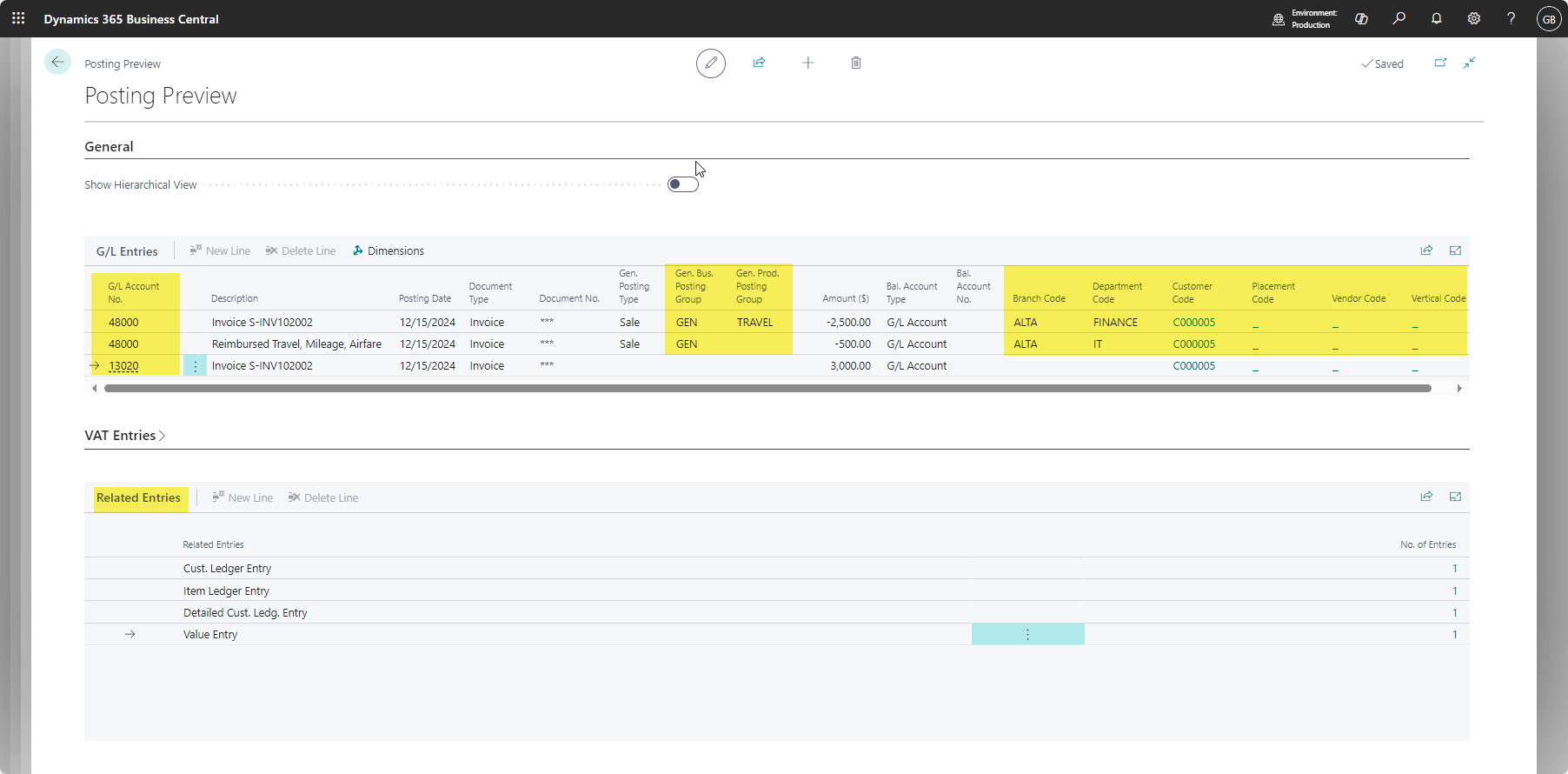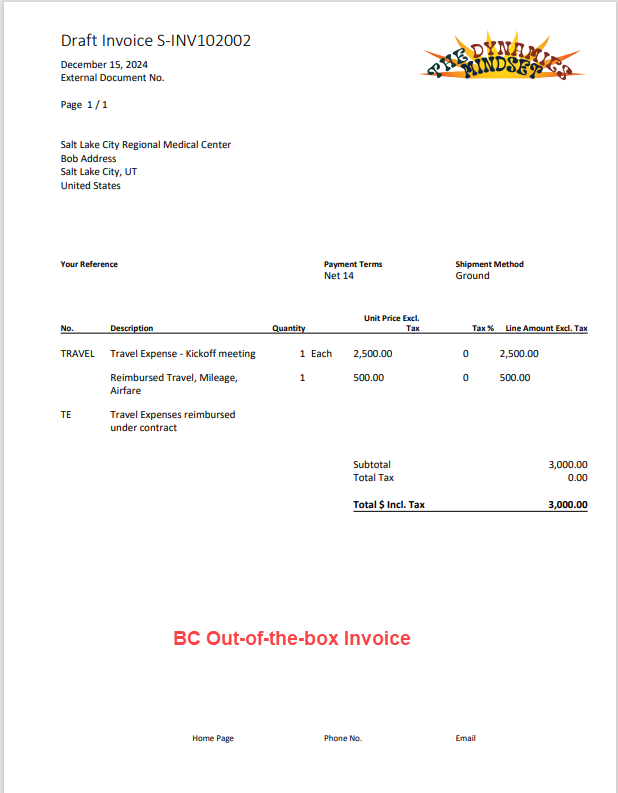Let’s Compare: GP to BC Sales Invoice Transactions
I’m a visual person, and while I have seen Dynamics GP and Business Central windows many times, I like to see them next to each other, for comparison sometimes. I often consume precious time logging in and creating transactions or looking up the window in the application just to see and confirm something. I suppose it’s been my way of paying the ‘toggle tax’ sometimes. But no more! This post starts a series I’ll be doing on comparing transactions. Why not start with one of the bigger ones first?
Sales Order Processing in GP vs Sales Invoice in Business Central
Recently, I undertook the journey of comparing Sales Invoices between Dynamics GP and Business Central (BC). This exercise provided valuable insights and serves as a useful reference for future discussions and comparisons. I hope it also helps those looking at BC or migrating over from GP ASP (at some point). All of the screenshots are shared at the bottom, but first, I have a number of thoughts about this exercise and observations about the differences between systems that could impact your migration to BC:
Mapping most fields between GP and BC is fairly straightforward. I highlighted the obvious ones that map cleanly, showing their positions in the GP window compared to the BC pages in a web-based layout. This was not a scientific exercise, but it has proven useful at a high level for discussion and comparison purposes, especially visually, for an end-user.
The primary reason I am choosing to not go down the rabbit hole of locking in every possible screenshot here is the power of Personalization in BC. There are many field values available on the sales invoice lines in the database, and the end user can choose how to arrange and present those on their own pages in BC. This flexibility reduces the need for extensive screenshots, as many fields available in the database can be mapped to Dynamics GP, even if not visually present.
Due to the way GP users currently rely on various date fields at both the header and line levels of invoices, as well as the label differences and functionality differences between the two ERP solutions, I performed a loose mapping to expose many commonly used dates.
Sales discounts and pricing for items in BC are set up differently than in GP, and the same is true for how Tax Codes and Shipping Methods (and Shipping Agents and Shipping Agent Services) work.
Fast Tabs define the logical sections on the Sales Invoices page in BC and consist of a General, Lines, Invoice Details, a Shipping and Billing section. BC clearly organizes and lays out the data differently than in GP, but it is easy to see which parts are the header vs the lines vs the footer of the sales document.
ISV solutions and modifications to Dynamics windows can distort the true out-of-the-box comparison, so these were not included, so your screens may look different than mine.
This post is not intended to cover an in-depth functionality review, or pit one product against the other, but rather get you in the “Dynamics Mindset” so you can be informed about migrating to Business Central!
Important Considerations
One of the most significant differences between GP and BC is the length of Item numbers. BC only allows for 20 characters, whereas GP allows for 30. This significant difference may require additional discussion, thought, or workarounds during the transition and migration of master record data, open orders and open purchase orders. No matter what you heard, BC is not GP in the cloud.
Another consideration is the field length differences for Ship-To and Bill-To ID’s coming from GP. BC's address code length is a whopping 10 characters, while GP's is 50% longer at 15 characters. This may not be a problem for many users, but it's worth noting because it affects a number of master record migrations for customers as well as vendors.
While BC has Sales Quotes, Orders, Invoices and Returns, it does not currently offer a Back Order as an available document type. Any functionality GP offers and handles will need to be considered along with native processing and your workflow when migrating to BC for back orders.
For those GP users who like their Revenue and Expense Deferral module, Business Central has you covered on your Sales Invoice lines. It handles the accounting and the revenue recognition over the assigned period if the feature is used.
For those who utilize Repeating Orders in GP, a comparable solution in Business Central would likely be the Recurring Sales Lines feature, where a customer’s default order information is saved to a card, and a repeatable invoice can be generated over and over again. Order documents themselves in BC do not have a recurring nature to them.
BC does not offer the same User-Defined Field options or flexibility out-of-the-box that GP does. This could be overcome by repurposing other fields (warning - there are not many to choose from), doing some development to add what you need, or getting an ISV solution that does it for you. However, I firmly believe this is a significant oversight and a huge miss for BC, making it challenging for Dynamics GP users because they use UDF fields all over the place for a variety of good reasons.
One fascinating thing for any GP user about sales invoices in BC should be the ability to use sales Item Types of General Ledger, instead of an actual item coming from the item list. Many people utilize ‘fake’ items, with a sales or revenue account on them, that don't actually live on shelves and don't show up on purchase orders. They are there just to get a sales invoice out the door or revenue posted in the general ledger. When you transition to Business Central, any of those types of invoicing could instead use a GL item type to get the revenue recognition exactly where you need it, instead of littering the real item list with things that don't belong, are tough to set up, or really add much value. Similar to GP, BC does offer both Non-Inventory and Service type items, however the item code maximum length of 20 still applies.
If you ship stuff, you need to figure that out as part of your implementation. GP did not have native shipping functionality with the outside world, and neither does Business Central. Both ERP systems work on the premise of managing the products, the costs and the prices, with the expected quantities in the warehouses, and on the shelves or in the bins, but the actual warehouse and fulfillment systems will need to be connected to Business Central just like it was for GP. This actually opens doors since BC is already cloud-based to begin with. There is a broad spectrum of shipping and warehousing ISV solutions available for consideration, and some have solutions for both GP and BC, so your transition may not be as complicated in this regard as it could be if you can keep your current provider.
Printing Pick Lists, Packing Slips and Sales Invoices is something you can do in both systems, however the report layouts and fields will not be the same, and will likely need adjustments to fit your brand and overall approval. Thankfully Business Central has a single place where you load your logo for the customer-facing documents.
Unfortunately for Dynamics GP users, the batching concept for sales invoices does not exist in Business Central. Sales invoices in BC are simply documents that live in an unposted status. The Sales Invoices list page can sort, group, and filter the unposted the invoices, thereby enabling the use of a multi select action to create a ‘group’ as needed for posting. This is a key difference for GP users that will take some serious getting used to for many companies, especially those whose processes rely on specific batch naming, transferring documents among batches, batch approvals and batch posting routines. Posted Sales Invoices in BC are automatically archived, while Customer Ledger Entries are created and available for receivables management thereafter. Curiously in BC, posting can be set up as a background task for processing ‘off-camera’ from the end user. Thankfully, financial dimensions CAN be corrected after posting to the general ledger, so voiding is less common or necessary for some types of adjustments.
I have 4 observations about the General Ledger distributions, because these are wicked important, and dramatically different, than GP. First, for real inventory items, the MAIN sales/revenue account, and the MAIN COGS accounts are determined by the cross-section of the General Business Posting Group and the General Product Posting Group in Business Central. Second, the Receivables account is determined by the Customer Posting Group. Third, the dimension codes are visible and can be edited right on the sales lines (SUPER cool!!, no extra windows!). Fourth, You can ‘preview’ what MAIN GL accounts are going to be used by engaging the Preview Posting function, because it shows all of the proposed ledger entries and is pretty nifty too! There is a Test Report, but it does not show all of the GL distributions. Unfortunately there is no ‘EDIT LIST’ in Business Central similar to what we know in Dynamics GP as a Batch Edit List (documents don’t live in batches in BC, see #10 above).
I saved a peculiar one for last - the Numbering Series. Business Central automatically assigns the next invoice number based on the setup, however unlike Great Plains, which has different document types, each with their own numbering series, only one number series can be used for BC. Manually-created invoice numbers, and also unique invoice numbers imported from external systems can override the auto-numbering behavior. Perhaps the most maddening thing about sales invoices in Business Central for this experienced GP user is the complete inability to delete an invoice and have it entirely disappear. For some dumb reason Business Central thinks it's important to keep every deleted document!! NO, you can’t just delete, despite what the DELETE button says! Furthermore, this shortsightedness interferes with the ability to use and test some integrations. It ALSO, in its own maddening way of laughing at you, forces you to then filter out all of that crap from your analytics and posted document and ledger entry pages!! So beware GP user! Business Central natively behaves as though the Great Plains VOID feature were always in use. Do ensure your team does all of their TEST transactions in a TEST company - ALWAYS, to avoid creating clutter in your production company database! I hope they fix this someday… [ADDENDUM - Cynthia Priebe, MVP has a great writeup on her LinkedIn site that provides excellent configuration advice for setting up the numbering series - please check it out!
Thanks for sticking in there for a lengthy write up.
You can now enjoy the SOP for GP to BC comparison images below.
GP Sales Order Processing Windows
GP Sales Order Processing Invoice
Dynamics 365 Business Central - Sales Invoice Entry Page
BC Posting Preview
BC Sales Invoice
Overall….
Transitioning from Dynamics GP to Business Central involves several considerations, especially regarding sales invoices. While BC offers flexibility and personalization across the board, there are notable differences in field lengths, document types, numbering, posting, and user-defined fields between these ERP systems. Understanding these differences and planning accordingly can help ensure a smooth and efficient transition for your organization.
I’m grateful should this experience or these insights be helpful to you on your journey…until next post!








